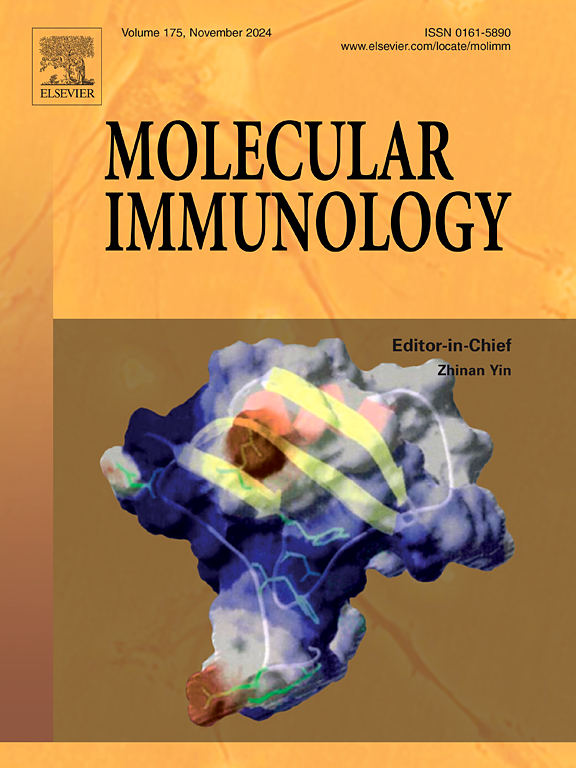在胶原诱导的关节炎小鼠模型中,莲子碱通过抑制NF-κB/NLRP3炎症小体轴减少滑膜炎症和心脏并发症
IF 3
3区 医学
Q2 BIOCHEMISTRY & MOLECULAR BIOLOGY
引用次数: 0
摘要
在治疗类风湿性关节炎(RA)方面,副作用较小的药物选择有限。奈非林具有抗炎、抗纤维化和保护心脏的特性,但其治疗类风湿性关节炎的效果仍不明确。我们的研究旨在探讨服用奈非林对胶原诱导的关节炎(CIA)小鼠踝关节炎症和心脏并发症的影响。我们通过在雄性DBA/1小鼠尾部皮下注射II型胶原蛋白(CII)来建立CIA模型。我们发现,奈非林减轻了踝关节炎症、软骨侵蚀和骨破坏,并降低了CIA小鼠血清中IL-6、TNF-α、IL-1β和IL-18的水平。此外,奈非林还能减少 CIA 小鼠踝关节滑膜损伤标志物(RANKL、MMP-3 和 MMP-13)的表达。从机理上讲,奈非林降低了 CIA 小鼠滑膜组织中 NF-κB 通路相关分子(如 p-IκBα、p-p65 和核 p65)的水平。同时,奈非林逆转了 CIA 小鼠滑膜组织中 NLRP3、ASC 和裂解-caspase-1 水平的上调。此外,我们的研究结果表明,奈非林降低了心肌损伤标志物(cTnI、CK-MB 和 LDH)的含量,缓解了心肌纤维化,降低了 α-SMA 和胶原 I 的表达,并减轻了与纤维化相关的 TGF-β/Smad 信号的激活。总之,我们的研究表明,奈非林通过抑制NF-κB/NLRP3炎性体的激活,减轻了CIA小鼠模型中的软骨和滑膜炎症,而且奈非林对CIA小鼠的心脏具有保护作用。本文章由计算机程序翻译,如有差异,请以英文原文为准。
Neferine reduces synovial inflammation and cardiac complications in a collagen-induced arthritis mouse model via inhibiting NF-κB/NLRP3 inflammasome axis
For the treatment of rheumatoid arthritis (RA), there are limited options for drugs with fewer side effects. Neferine possesses anti-inflammatory, anti-fibrotic, and cardioprotective properties, but its effectiveness in the treatment of RA remains unclear. Our study aimed to explore the impact of neferine administration on ankle joint inflammation and cardiac complications of collagen-induced arthritis (CIA) mice. The CIA model was introduced in male DBA/1 mice via subcutaneous injection of Type II collagen (CII) into the tail. We found that neferine alleviated ankle joint inflammation, cartilage erosion, and bone destruction, as well as reduced the levels of IL-6, TNF-α, IL-1β, and IL-18 in the serum of CIA mice. Furthermore, neferine reduced the expression of synovial damage markers (RANKL, MMP-3, and MMP-13) in the ankle joints of CIA mice. Mechanistically, neferine lowered the levels of NF-κB pathway-related molecules such as p-IκBα, p-p65, and nuclear p65 in the synovial tissue of CIA mice. Simultaneously, neferine reversed the upregulation of NLRP3, ASC, and cleaved-caspase-1 levels in the synovial tissue of CIA mice. Additionally, our results showed that neferine reduced the contents of myocardial injury markers (cTnI, CK-MB, and LDH), alleviated myocardial fibrosis, decreased expression of α-SMA and Collagen I, as well as mitigated the activation of fibrosis-related TGF-β/Smad signaling. In summary, our study demonstrates that neferine attenuates chondral and synovial inflammation in a CIA mouse model by inhibiting the activation of the NF-κB/NLRP3 inflammasome, and neferine has a protective effect on the hearts of CIA mice.
求助全文
通过发布文献求助,成功后即可免费获取论文全文。
去求助
来源期刊

Molecular immunology
医学-免疫学
CiteScore
6.90
自引率
2.80%
发文量
324
审稿时长
50 days
期刊介绍:
Molecular Immunology publishes original articles, reviews and commentaries on all areas of immunology, with a particular focus on description of cellular, biochemical or genetic mechanisms underlying immunological phenomena. Studies on all model organisms, from invertebrates to humans, are suitable. Examples include, but are not restricted to:
Infection, autoimmunity, transplantation, immunodeficiencies, inflammation and tumor immunology
Mechanisms of induction, regulation and termination of innate and adaptive immunity
Intercellular communication, cooperation and regulation
Intracellular mechanisms of immunity (endocytosis, protein trafficking, pathogen recognition, antigen presentation, etc)
Mechanisms of action of the cells and molecules of the immune system
Structural analysis
Development of the immune system
Comparative immunology and evolution of the immune system
"Omics" studies and bioinformatics
Vaccines, biotechnology and therapeutic manipulation of the immune system (therapeutic antibodies, cytokines, cellular therapies, etc)
Technical developments.
 求助内容:
求助内容: 应助结果提醒方式:
应助结果提醒方式:


